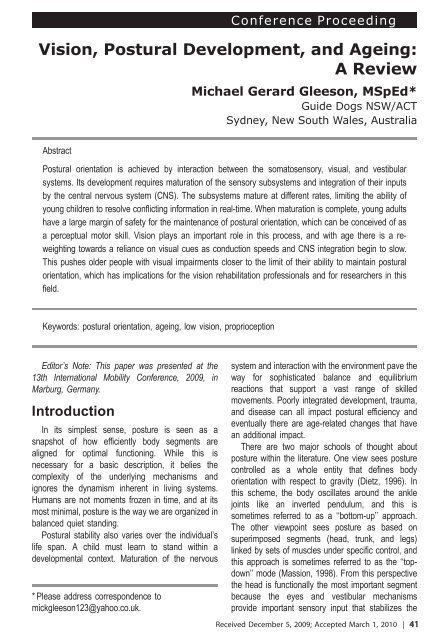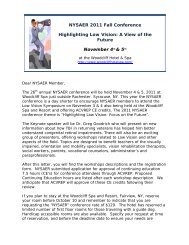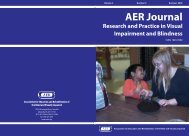Association for Education and Rehabilitation of the Blind - AER Online
Association for Education and Rehabilitation of the Blind - AER Online
Association for Education and Rehabilitation of the Blind - AER Online
Create successful ePaper yourself
Turn your PDF publications into a flip-book with our unique Google optimized e-Paper software.
Vision, Postural Development, <strong>and</strong> Ageing:<br />
A Review<br />
Abstract<br />
Michael Gerard Gleeson, MSpEd*<br />
Guide Dogs NSW/ACT<br />
Sydney, New South Wales, Australia<br />
Postural orientation is achieved by interaction between <strong>the</strong> somatosensory, visual, <strong>and</strong> vestibular<br />
systems. Its development requires maturation <strong>of</strong> <strong>the</strong> sensory subsystems <strong>and</strong> integration <strong>of</strong> <strong>the</strong>ir inputs<br />
by <strong>the</strong> central nervous system (CNS). The subsystems mature at different rates, limiting <strong>the</strong> ability <strong>of</strong><br />
young children to resolve conflicting in<strong>for</strong>mation in real-time. When maturation is complete, young adults<br />
have a large margin <strong>of</strong> safety <strong>for</strong> <strong>the</strong> maintenance <strong>of</strong> postural orientation, which can be conceived <strong>of</strong> as<br />
a perceptual motor skill. Vision plays an important role in this process, <strong>and</strong> with age <strong>the</strong>re is a reweighting<br />
towards a reliance on visual cues as conduction speeds <strong>and</strong> CNS integration begin to slow.<br />
This pushes older people with visual impairments closer to <strong>the</strong> limit <strong>of</strong> <strong>the</strong>ir ability to maintain postural<br />
orientation, which has implications <strong>for</strong> <strong>the</strong> vision rehabilitation pr<strong>of</strong>essionals <strong>and</strong> <strong>for</strong> researchers in this<br />
field.<br />
Keywords: postural orientation, ageing, low vision, proprioception<br />
Editor’s Note: This paper was presented at <strong>the</strong><br />
13th International Mobility Conference, 2009, in<br />
Marburg, Germany.<br />
Introduction<br />
In its simplest sense, posture is seen as a<br />
snapshot <strong>of</strong> how efficiently body segments are<br />
aligned <strong>for</strong> optimal functioning. While this is<br />
necessary <strong>for</strong> a basic description, it belies <strong>the</strong><br />
complexity <strong>of</strong> <strong>the</strong> underlying mechanisms <strong>and</strong><br />
ignores <strong>the</strong> dynamism inherent in living systems.<br />
Humans are not moments frozen in time, <strong>and</strong> at its<br />
most minimal, posture is <strong>the</strong> way we are organized in<br />
balanced quiet st<strong>and</strong>ing.<br />
Postural stability also varies over <strong>the</strong> individual’s<br />
life span. A child must learn to st<strong>and</strong> within a<br />
developmental context. Maturation <strong>of</strong> <strong>the</strong> nervous<br />
* Please address correspondence to<br />
mickgleeson123@yahoo.co.uk.<br />
Conference Proceeding<br />
system <strong>and</strong> interaction with <strong>the</strong> environment pave <strong>the</strong><br />
way <strong>for</strong> sophisticated balance <strong>and</strong> equilibrium<br />
reactions that support a vast range <strong>of</strong> skilled<br />
movements. Poorly integrated development, trauma,<br />
<strong>and</strong> disease can all impact postural efficiency <strong>and</strong><br />
eventually <strong>the</strong>re are age-related changes that have<br />
an additional impact.<br />
There are two major schools <strong>of</strong> thought about<br />
posture within <strong>the</strong> literature. One view sees posture<br />
controlled as a whole entity that defines body<br />
orientation with respect to gravity (Dietz, 1996). In<br />
this scheme, <strong>the</strong> body oscillates around <strong>the</strong> ankle<br />
joints like an inverted pendulum, <strong>and</strong> this is<br />
sometimes referred to as a ‘‘bottom-up’’ approach.<br />
The o<strong>the</strong>r viewpoint sees posture as based on<br />
superimposed segments (head, trunk, <strong>and</strong> legs)<br />
linked by sets <strong>of</strong> muscles under specific control, <strong>and</strong><br />
this approach is sometimes referred to as <strong>the</strong> ‘‘topdown’’<br />
mode (Massion, 1998). From this perspective<br />
<strong>the</strong> head is functionally <strong>the</strong> most important segment<br />
because <strong>the</strong> eyes <strong>and</strong> vestibular mechanisms<br />
provide important sensory input that stabilizes <strong>the</strong><br />
Received December 5, 2009; Accepted March 1, 2010 | 41







